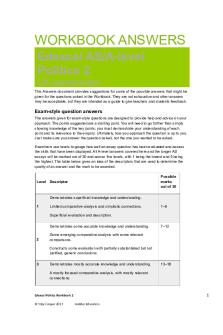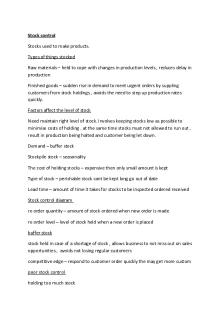Stock control - Edexcel business AS/Alevel PDF

| Title | Stock control - Edexcel business AS/Alevel |
|---|---|
| Course | business unit 2 |
| Institution | South and City College Birmingham |
| Pages | 3 |
| File Size | 64.2 KB |
| File Type | |
| Total Downloads | 75 |
| Total Views | 145 |
Summary
Edexcel business AS/Alevel...
Description
Stock control Stocks used to make products. Types of things stocked Raw materials – held to cope with changes in production levels , reduces delay in production Finished goods – sudden rise in demand to meet urgent orders by suppling customers from stock holdings , avoids the need to step up production rates quickly. Factors affect the level of stock Need maintain right level of stock. Involves keeping stocks low as possible to minimise costs of holding . at the same time stocks must not allowed to run out , result in production being halted and customer being let down. Demand – buffer stock Stockpile stock – seasonality The cost of holding stocks – expensive then only small amount is kept Type of stock – perishable stock cant be kept long go out of date Lead time – amount of time it takes for stocks to be inspected ordered received Stock control diagram re order quantity – amount of stock ordered when new order is made re order level – level of stock held when a new order is placed buffer stock stock held in case of a shortage of stock , allows business to not miss out on sales opportunities , avoids not losing regular customers competitive edge – respond to customer order quickly the may get more custom poor stock control holding too much stock
unsold stock opportunity cost – capital used to in stocks earn no rewards whereas if money used for new machinery earned business money storage – pay heating , lightning , labour costs ( security) too little stock delays , sudden increase in demand , miss out on economies of scale little quantities JIT stock control method where the business doesn't store any raw materials. Instead, it has regular deliveries that bring only what is needed before its existing raw materials run out Improves cash flow forecast since money isn’t tied up in stocks Reduces waste and damaged stocks Reduce cost of stock holding
A lot faith is placed in the reliability and flexibility of suppliers Increased orders and administration costs Advantages of bulk buying lost Vulnerable to break in supply and machinery break downs Ruins business rep is customers are let down by late delivers
Business have to be diligent when forecasting demands patterns for perishable goods . if they overestimate demand they could be left with a lot of unsold stock . some business use complex quantitative techniques to predict demand of perishable goods . such techniques use historic data relating to demand , the shelf life of productions lead times and storage costs. Stock control FIFO , stocks delivered first should be sold first Computerized systems order stock when stocks have finished , record every time purchased by consumers and take it away from the total stock levels. Competitive advantage of lean productions
Lean production aims to use fewer resources in production. Less stock , labour space and fewer suppliers Reduction in waste and resources will lower production costs Improves reliability Charge lower prices , offer better quality and reliability , fight off rivals in the global market place...
Similar Free PDFs

Automatic Stock Control
- 6 Pages

Edexcel-unit4a-brompton 2010
- 10 Pages

Edexcel M1 Revision Sheets
- 10 Pages

Stock options vs stock warrants
- 1 Pages

Politics Edexcel Workbook 2 Answers
- 43 Pages

June 2015 QP - C2 Edexcel
- 17 Pages

June 2015 MS - C2 Edexcel
- 18 Pages

Trading Stock Summary-1
- 2 Pages

Stock Exchange of Mauritius
- 15 Pages
Popular Institutions
- Tinajero National High School - Annex
- Politeknik Caltex Riau
- Yokohama City University
- SGT University
- University of Al-Qadisiyah
- Divine Word College of Vigan
- Techniek College Rotterdam
- Universidade de Santiago
- Universiti Teknologi MARA Cawangan Johor Kampus Pasir Gudang
- Poltekkes Kemenkes Yogyakarta
- Baguio City National High School
- Colegio san marcos
- preparatoria uno
- Centro de Bachillerato Tecnológico Industrial y de Servicios No. 107
- Dalian Maritime University
- Quang Trung Secondary School
- Colegio Tecnológico en Informática
- Corporación Regional de Educación Superior
- Grupo CEDVA
- Dar Al Uloom University
- Centro de Estudios Preuniversitarios de la Universidad Nacional de Ingeniería
- 上智大学
- Aakash International School, Nuna Majara
- San Felipe Neri Catholic School
- Kang Chiao International School - New Taipei City
- Misamis Occidental National High School
- Institución Educativa Escuela Normal Juan Ladrilleros
- Kolehiyo ng Pantukan
- Batanes State College
- Instituto Continental
- Sekolah Menengah Kejuruan Kesehatan Kaltara (Tarakan)
- Colegio de La Inmaculada Concepcion - Cebu






